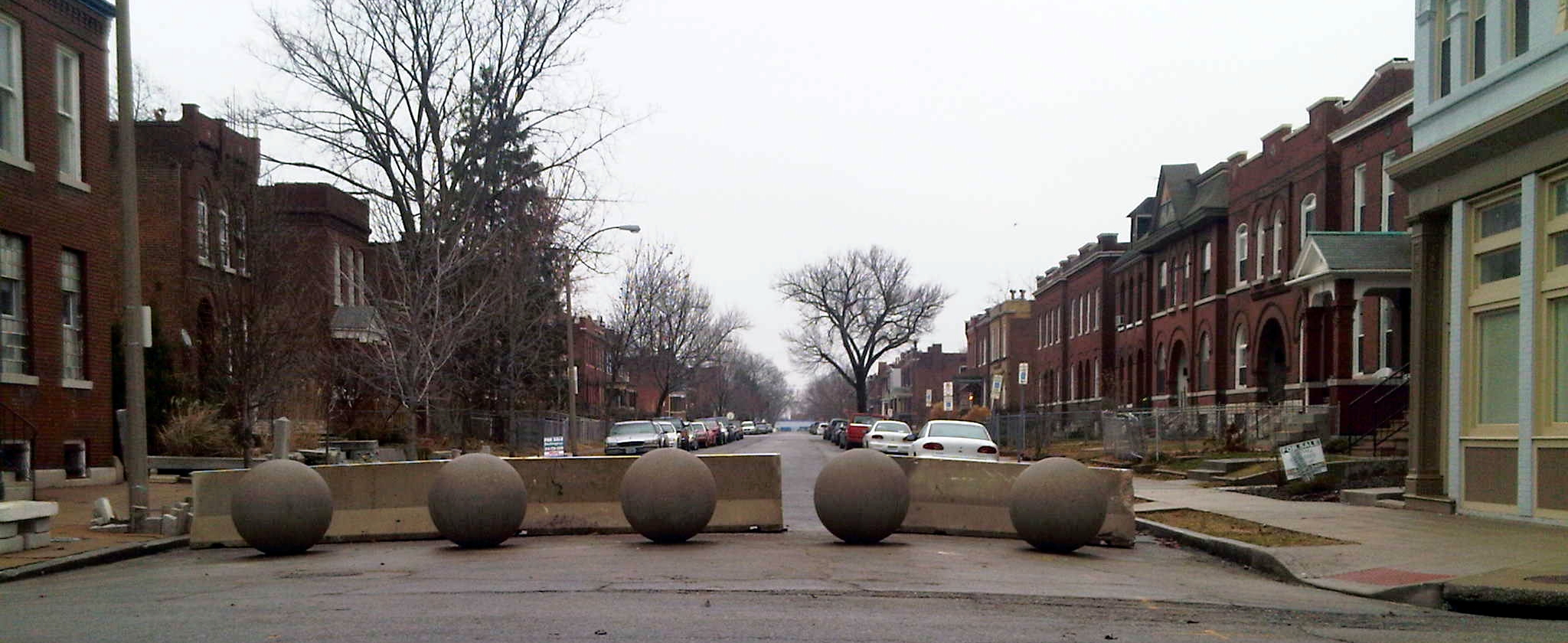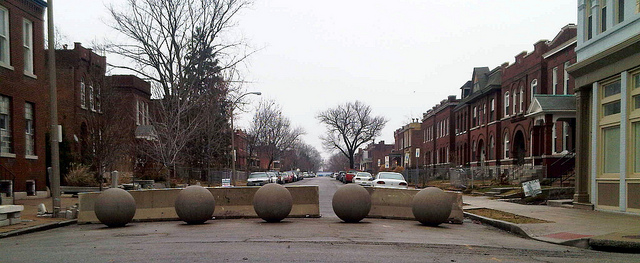
Hey, I got my Potluck PAC submission completed. It’s a basic outline, thrown together quickly… but it’s something I’ve spent quite a significant amount of time considering since I moved onto a city block barricaded at one end with “temporary” Schoemehl pots. That was 2006 and I thought they were awful. I bought a home with the hope that “temporary” meant they would be gone sooner than later. Seven years later I’m gone, but the barricades remain. In fact, the old neighborhood, Forest Park Southeast (AKA The Grove), spent thousands of dollars for new, prettier barricades.
Why does this matter? In addition to some very fundamentally important issues of civic governance and process, closing 262 city streets changes the nature of the city, the historic city form. Of course this is what was desired. We’ve closed streets as crime prevention, to create safer places for children to play, to decrease traffic (or push it elsewhere) – all without study or evidence that the quickly adopted solution solved the purported problem, and without consideration of the larger city. The city is suburbanized with tiny defacto cul-de-sacs and chopped up with dead ends. There are entire neighborhoods where I will never consider living because I’m unfamiliar with them, becuase they’re purposely isolated from the larger city. On my old street, traffic was twice what it need to be, as everyone on the block drove past my home twice coming and going. I could go on… Anyway, below is the basic proposal. To read more about the history of this issue in St. Louis, read: Streets Not Through: An Analysis of the Blockages and Barricades to the St. Louis Street Network.
Proposal:
Require reauthorization of City of St. Louis streets closed temporarily by ordinance and codify the process by which a city street may be closed and re-opened. Some of these “temporary” closures have been in place more than 20 years without a process to address or even a definition to understand their “temporary” status.
An exhaustive study of the history of closed streets in the City of St. Louis found 262 streets that used to be contiguous, but that are no longer throughways. This initiative is important for several reasons. First, it would bring before residents one of the most important basic functions of a city, its streets. It would also present clarity to this basic civic governance issue.
Today, there’s no codified process by which a city street is closed or re-opened. Anecdotally, a resident complains to an alderperson that people are running a stop sign, that drug buyers are cruising their block, or that they don’t feel their children are safe due to traffic. How many must complain? That’s up to an alderperson’s discretion. If the alderperson is persuaded to bring the issue to the city streets department, the most that department will do is consider traffic counts and basic traffic flow. Because the City of St. Louis is home to half a million fewer residents than 60 years ago, there are virtually no residential streets, and very few streets overall for which traffic counts dictate must stay open. So the street is closed, often as “temporary” by ordinance. “Temporary” isn’t defined, and the process by which a street is re-opened is unknown. Again, anecdotally, if a group of residents complain to an alderperson, that person may ask the city to address the concern. But who gets a say? What if the street borders two city wards? Should residents on all four corners have a say?
Hundreds of streets across St. Louis been closed at the request of the alderperson, ostensibly responding to residents. Typically no further study or examination of a closure was conducted before proceeding. No larger plan for city streets exits in the City of St. Louis. There is also no record of individual votes by the Board of Alderman to endorse a street closure (though these were likely unanimous under the practice of aldermanic courtesy), and no record of how many residents requested a closer. Was it the homeowner nearest the intersection? Was it half the residents of the block?
The question of whether a city street is open or closed is a fundamental part of our city. Such decisions should never be made at the request of a small number of people, or as a request by an alderperson, often without evidence. The closing of a city street, even temporarily, should require that the burden rest with those seeking a closure, a change to the historic and fundamental structure of the city. The burden should remain on those seeking to maintain a “temporary” street closure. Such closures should require reauthorization every two years. The method of the initial petition and the reauthorization should follow a similar process to that presented by the city’s Cultural Resources Office and Preservation Review Board. Evidence should be considered, opinions heard and an informed decision, one that addresses resident concerns, but also considers the value and function of city streets, made.
It’s simply not the case that a closed street only affects those living on that particular street. Traffic patterns are disrupted, the historic city altered, the aesthetic streetscape lessened. It should be unconscionable that a street that belongs to and is paid for by all city residents can be closed at the request of a few and without review.

